Content |
|---|
Characteristics "Chesapeake Bay Retriever"
Coexistence is important that you have with your new friend. Before considering the acquisition of a dog of the breed "Chesapeake Bay Retriever" you know certain factors. Not all breeds of dogs are apt to live in an apartment, you must take into account his character, their need for exercise, their interaction with other pets, their care and if you have small children, their level of tolerance towards them.
Adaptation ⓘ3.0 out of 5 stars (based on 1 review)
|
friendly dog ⓘ2.0 out of 5 stars (based on 1 review)
|
hair loss ⓘ3.0 out of 5 stars (based on 1 review)
|
|---|---|---|
Affection level ⓘ3.0 out of 5 stars (based on 1 review)
|
Need for exercise ⓘ5.0 out of 5 stars (based on 1 review)
|
Social need ⓘ3.0 out of 5 stars (based on 1 review)
|
Home ⓘ1.0 out of 5 stars (based on 1 review)
|
Toilet ⓘ2.0 out of 5 stars (based on 1 review)
|
Friendly with strangers ⓘ2.0 out of 5 stars (based on 1 review)
|
barking ⓘ3.0 out of 5 stars (based on 1 review)
|
Health ⓘ3.0 out of 5 stars (based on 1 review)
|
Territorial ⓘ3.0 out of 5 stars (based on 1 review)
|
Cat friendly ⓘ3.0 out of 5 stars (based on 1 review)
|
Intelligence ⓘ5.0 out of 5 stars (based on 1 review)
|
Versatility ⓘ5.0 out of 5 stars (based on 1 review)
|
Child friendly ⓘ3.0 out of 5 stars (based on 1 review)
|
Surveillance ⓘ4.0 out of 5 stars (based on 1 review)
|
joy ⓘ3.0 out of 5 stars (based on 1 review)
|
History
When a British brig was wrecked off the coast of Maryland in 1807, part of the cargo that was rescued included two Newfoundland dogs. Called Sailor and Canton, they were found to have excellent retrieval skills. The locals raised them with local dogs, and they became the ancestors of the “Chesapeake Bay Retriever”. Other breeds that may have contributed to the composition of the Chesapeake were “Flat-coated Retriever” and the “Curly-coated Retriever“.
The result was a hard Retriever that he was ready and willing to endure the harsh and icy Chesapeake Bay being able to recover from 100 to 200 ducks a day. The first dogs came only in dark brown, but now any shade of brown, sedge or dead grass is acceptable.
The American Kennel Club registered your first Chessie, called Sunday, in 1878. The Chesapeake is ranked 48 breeds registered by the AKC, under the 41 a decade.
Physical characteristics
Distinctive features include eyes very clear, yellow or amber, rear quarters as high or slightly higher than the shoulders, and a double layer which tends to wave on shoulders, the neck, back and loins.
The Raincoats feels slightly oily and often is associated with a slight musky odor. three basic colors are usually seen on race: the brown, which it includes all shades from light brown to a deep dark brown; sedge, ranging from reddish yellow to bright red and brown tones; and dead grass in all shades, ranging from a faded tan to a muted straw color.
The breed standard states that the target may also appear, but it should be limited to the chest, the belly, the toes or back of feet. The head is round and wide with an average stop and muzzle. The lips are thin, and ears are small and medium leather. The Forelegs should be straight with good bone. The hindquarters are especially strong and the toes webbed as excellent swimming ability is important to the Chesapeake.
This breed is also known for its large and powerful chest, used to break ice when submerged in cold water while duck hunting.
Character and skills
The “Chesapeake Bay Retriever” It is prized for its awake and cheerful disposition, his intelligence, his calm demeanor and his affectionate nature and protective. The value, the willingness to work, vivacity, good sense of smell, the intelligence, the enjoyment of the water and especially the general quality and the provisions should take priority when selecting and raising the “Chesapeake Bay Retriever”. Extreme shyness or aggression are not desirable in this breed, whether the animal is used as a hunting dog or pet.
In the countryside, the Chesapeake he is a serious worker and has even been called neurotic in his eagerness to find fallen birds. It's not out there to play. The Chesapeake They are known for their excellent vision and memories when it comes to seeing where birds fall and remembering where to go to collect them.. His favorite activity is hunting for ducks.
When you train, respects their learning ability. Don't continue training him long after it's clear he knows what to do. The perfect Chesapeake is not prepared by the breeder. any dog, no matter how pleasant it, detestable levels can develop barking, excavation and other undesirable behavior if you are bored, untrained or unsupervised.
Did you know??
The Chessie not designed to be a companion, is a hunting dog, pure and simple. And not just any old hunting dog… He is a waterfowl dog and lives to get wet in pursuit of his feathered prey..
Health “Chesapeake Bay Retriever”
According to a survey conducted in 2005 by the American Chesapeake Club, the most common health problems seen in the breed are hip dysplasia, progressive retinal atrophy and other eye problems, cancer, degenerative myelopathy and hypothyroidism. This breed can also be prone to a bleeding disorder called von Willebrand disease.
Find a breeder who uses the newly available genetic test for degenerative myelopathy, a form of progressive weakness and paralysis of the limbs. Although DM is rare, It is incurable and crippling. Not all dogs that test positive in the test of DM develop the disease, but farmers who try their race for this condition are probably the most conscientious.
The test can be used to determine whether a puppy's parents are clean, they are carriers or are at risk; a puppy whose parents are clean – neither carriers nor at risk – also will be. A puppy two carrier parents will be at risk, and a puppy parent with a carrier may be at risk. Even dogs tested for having two copies of the gene never show symptoms of the disease., but the status of the parents of your puppy, and his own dog, It can help you be aware of the early warning signs.
Careful breeders test their breeding dogs for genetic diseases and only breed the healthiest and best looking dogs., but sometimes mother nature has other ideas and a puppy develops one of these diseases despite good husbandry practices. Advances in veterinary medicine mean that in most cases dogs can still live a good life. If you're going to have a puppy, ask the breeder about the ages of the dogs in their lines and what they died of.
Remember that after hosting a new puppy home ut, has the power to protect you from one of the most common health problems: the obesity. Keep a “Chesapeake Bay Retriever” with a proper weight is one of the easiest ways to prolong your life. Make the most of your preventative abilities to help ensure a healthier dog for life.
Grooming “Chesapeake Bay Retriever”
The Chesapeake has a tough, oily outer coat over a dense undercoat, fine and wooly. The dirt and debris are easily removed with a rubber brush. The undercoat is very clear in spring, so be prepared to brush the dog more frequently during this time to prevent loose hair from collecting on clothing and furniture..
Give the Chessie Fresh water rinse after it has been in salt water or has swum in the mud of a pond or lake, but to keep the resistance of the coat to water, avoid bathing unless absolutely necessary. That can be as little as twice a year.
The rest is basic care. Keep your ears clean and dry so they don't get infected, and trim nails as needed, usually every two weeks. Brush your teeth for general good health and fresh breath.
Images “Chesapeake Bay Retriever”
credits:
1. A Chesapeake Bay Retriever by Keith Rousseau at en.wikipedia / CC BY-SA
2. Chesapeaker Bay retriever by Nevilley / CC BY-SA
3. Male, Chesapeake Bay Retriever competing in the conformation ring by George Makatura / Public domain
4. Chesapeaker Bay retriever by https://pxhere.com/es/photo/1407301
5. Chesapeaker Bay retriever by https://pixabay.com/es/photos/perros-mascotas-el-agua-1582148/
6. Chesapeake Bay Retriever by Diane – HTTPS://flic.kr/p/6k1uFQ
7. chesapeake bay retriever by https://www.peakpx.com/611264/chesapeake-bay-retriever
8. Brown Chesapeake Bay Retriever in the snow, carrying a plant part in its snout by Will Thomas / CC BY
Videos “Chesapeake Bay Retriever”
Type and recognitions:
- FCI CLASSIFICATION: 263
- Group 8: Retrievers - Flushing Dogs - Water Dogs
- Section 1: Retrievers. With working trial.
Federations:
FCI ⓘ, AKC ⓘ, ANKC ⓘ, CKC ⓘ, KC ⓘ, NZKC ⓘ, UKC ⓘ
FCI breed standard "Chesapeake Bay Retriever"
Alternative names:
1. Chessie, CBR, Chesapeake (English).
2. Chesapeake Bay Retriever, Chesapeake (French).
3. Chesapeake Bay Retriever (German).
4. Chesapeake bay retriever (Portuguese).
5. Chessie, CBR, Chesapeake (español).

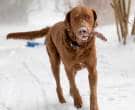
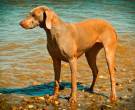
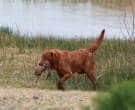
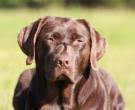
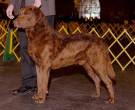
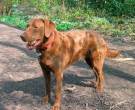
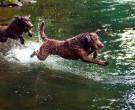
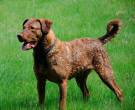
 Dogs 101: Chesapeake
Dogs 101: Chesapeake Chesapeake | Breed Judging 2020
Chesapeake | Breed Judging 2020 Breed All About It – Chesapeake
Breed All About It – Chesapeake Chesapeake
Chesapeake